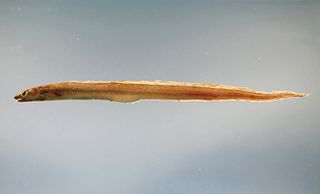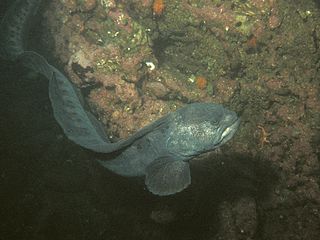
The swamp eels are a family (Synbranchidae) of freshwater eel-like fishes of the tropics and subtropics. Most species are able to breathe air and typically live in marshes, ponds and damp places, sometimes burying themselves in the mud if the water source dries up. They have various adaptations to suit this lifestyle; they are long and slender, they lack pectoral and pelvic fins, and their dorsal and anal fins are vestigial, making them limbless vertebrates. They lack scales and a swimbladder, and their gills open on the throat in a slit or pore. Oxygen can be absorbed through the lining of the mouth and pharynx, which is rich in blood vessels and acts as a "lung".

Moray eels, or Muraenidae, are a family of eels whose members are found worldwide. There are approximately 200 species in 15 genera which are almost exclusively marine, but several species are regularly seen in brackish water, and a few are found in fresh water.

Conger is a genus of marine congrid eels. It includes some of the largest types of eels, ranging up to 2 m (6 ft) or more in length, in the case of the European conger. Large congers have often been observed by divers during the day in parts of the Mediterranean Sea, and both European and American congers are sometimes caught by fishermen along the European and North American Atlantic coasts.

Ophichthidae is a family of fish in the order Anguilliformes, commonly known as the snake eels. The term "Ophichthidae" comes from Greek ophis ("serpent") and ichthys ("fish"). Snake eels are also burrowing eels. They are named for their physical appearance, as they have long, cylindrical, snake-like bodies. This family is found worldwide in tropical to warm temperate waters. They inhabit a wide range of habitats, from coastal shallows and even rivers, to depths below 800 m (2,600 ft). Most species are bottom dwellers, hiding in mud or sand to capture their prey of crustaceans and small fish, but some are pelagic.

The superorder Elopomorpha contains a variety of types of fishes that range from typical silvery-colored species, such as the tarpons and ladyfishes of the Elopiformes and the bonefishes of the Albuliformes, to the long and slender, smooth-bodied eels of the Anguilliformes. The one characteristic uniting this group of fishes is they all have leptocephalus larvae, which are unique to the Elopomorpha. No other fishes have this type of larvae.

The cusk-eel family, Ophidiidae, is a group of marine bony fishes in the Ophidiiformes order. The scientific name is from the Greek ophis meaning "snake", and refers to their eel-like appearance. True eels diverged from other ray-finned fish during the Jurassic, while cusk-eels are part of the Percomorpha clade, along with tuna, perch, seahorses and others.

Nettastomatidae, the duckbill eels or witch eels are a family of eels. The name is from νῆττα and στόμα.
Macrognathus is a genus of eel-like fish of the family Mastacembelidae of the order Synbranchiformes.

The wolf eel is a species of marine ray-finned fish belonging to the family Anarhichadidae, the wolf fishes. It is found in the North Pacific Ocean. Despite its common name and resemblance, it is not a true eel. It is the only species in the monotypic genus Anarrhichthys.

Eels are ray-finned fish belonging to the order Anguilliformes, which consists of eight suborders, 20 families, 164 genera, and about 1000 species. Eels undergo considerable development from the early larval stage to the eventual adult stage and are usually predators.
Notacanthus is a genus of spiny eels in the family Notacanthidae.

Protanguilla palau is a species of eel, the only species in the genus Protanguilla, which is in turn the only genus in its family, Protanguillidae. Its common name is Palauan primitive cave eel. Individuals were found swimming in March 2010 in a deep underwater cave in a fringing reef off the coast of Palau.
Dalophis multidentatus is an eel in the family Ophichthidae. It was described by Jacques Blache and Marie-Louise Bauchot in 1972. It is known from a single specimen collected from the Saloum River in Senegal, in the eastern Atlantic Ocean. It is known through this specimen to form burrows in sand or mud on the continental shelf, and to dwell at a depth of 50 m (160 ft). Males are able to reach a total length of 15.3 cm (6.0 in).
Dalophis obtusirostris is an eel in the family Ophichthidae. It was described by Jacques Blache and Marie-Louise Bauchot in 1972. It is a tropical, marine eel which is known from the eastern Atlantic Ocean, including Mauritania and Senegal. It inhabits estuaries and forms burrows in sand or mud. Males can reach a maximum total length of 38.8 centimetres.
Ethadophis epinepheli is an eel in the family Ophichthidae. It was described by Jacques Blache and Marie-Louise Bauchot in 1972. It is a tropical, marine eel which is known from a single specimen recovered from the stomach of a grouper in Senegal, in the eastern Atlantic Ocean. It is known to reach a total length of 42.4 centimetres.
The Molo snake eel is an eel in the family Ophichthidae. It was described by Max Carl Wilhelm Weber in 1913. It is a marine, tropical eel which is known from Indonesia, in the Indo-Pacific. It dwells at a depth range of 69 to 91 metres, and inhabits sandy sediments. Males can reach a maximum total length of 11.5 centimetres (4.5 in).
Hemerorhinus opici is an eel in the family Ophichthidae. It was described by Jacques Blache and Marie-Louise Bauchot in 1972. It is a marine, tropical eel which is known from the eastern Atlantic Ocean, including Senegal and Angola. It inhabits shallow waters near to shore, and forms burrows in sand and mud substrates. Males can reach a maximum total length of 32.5 centimetres (12.8 in).

The electric eels are a genus, Electrophorus, of neotropical freshwater fish from South America in the family Gymnotidae. They are known for their ability to stun their prey by generating electricity, delivering shocks at up to 860 volts. Their electrical capabilities were first studied in 1775, contributing to the invention in 1800 of the electric battery.
Cyvirus anguillidallo1, also known as Anguillid herpesvirus 1 (AngHV-1) is a species of virus in the genus Cyprinivirus, family Alloherpesviridae, and order Herpesvirales.










